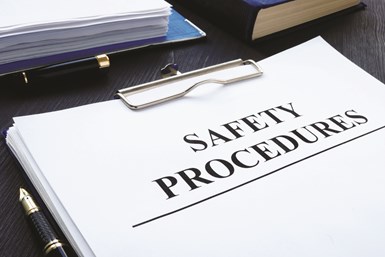Can your shop afford penalties as high as $13,494 per day for a serious Occupational Health and Safety Administration (OSHA) violation or $134,937 per day for one repeat violation? Can it afford to lose a talented employee for an extended period of time because of injury or occupational illness? One way to prevent such scenarios is to embed safety mindfulness into your shop culture.
But, how do you do that? Here, Miles Free, director of industry affairs, Precision Machined Products Association (PMPA), offers the following five tips on how to not only establish such a safety culture but also how to manage and sustain it.
1) Champion a Safety Culture
It is critical that proper safety training is championed by a shop’s upper management before injury or near-injury occurs on the shop floor. Free experienced the latter at his first job in a steel mill. “My first day on the job, I had a near miss with a 15-inch pipe wrench falling from above to the floor right next to me,” Free says. “I got the fear of the Lord pretty quick. That’s when I decided safety was going to be my thing.”
After his steel mill experience and eventually regularly visiting precision machine shops (in pre-coronavirus years), Free knows just how vulnerable shop employees, or performers as he calls them, really are to danger in their work environments. He also understands that too many shops simply do not have a safety mindset. In general, they realize the importance of safety, but getting work to their customers on time remains at top of mind. He adds that the numerous health and safety regulations that have been implemented by OSHA, the Environmental Protection Agency (EPA) and other federal agencies can be overwhelming.
But, more important than simply scheduling training is upper management’s genuine concern for their performers’ wellbeing.
To create an environment that advocates for safety first, managers should lead or prompt regular, formal safety meetings, safety talks, huddles or lunch-and-learn training sessions. Some shops even assign mentors to every new performer to help with training.
But, more important than simply scheduling training is upper management’s genuine concern for their performers’ wellbeing, according to Free. When everyone in the building sees that their managers care, and performers understand why each safety procedure is critical, that is when a safety mindset begins to eventually trickle down to all shop performers.
Leading by example is another way for managers to be taken seriously. Complying with simple personal safety rules, such as wearing safety glasses on the shop floor, goes a long way. But managers should also be proactive with teaching safety on the shop floor during a regular workday. For instance, when they see that a performer is not demonstrating safety the way they’ve been trained, managers should remind them of the proper safety measures immediately and show them the right way.
When a shop’s safety culture is strong, the performers within the organization are confident in their ability to decide what actions are safe and which are not safe. Many performers are fearful of making the right choices between safety and getting fired, but any good manager will praise a performer for stopping the line to follow safety precautions rather than put themselves at risk, according to Free.
2) Document Processes
Although OSHA provides regulations for safety in machine shops, the machine shop itself is responsible for writing down the details of how these safety procedures should be executed. Documentation of safety processes is critical because it puts the process down on paper for all to follow, and it calls for consistency throughout the company. “Having a formal process eliminates personal variability and ensures that all performers are provided equal protection,” Free says. “And, because it is documented, it can be reviewed, revised and continuously improved.”

Although OSHA provides regulations for safety in machine shops, the machine shop itself is responsible for writing down the details of how these safety procedures should be executed.
He continues that in the event there is an accident or incident without injury, the process can be reexamined, identifying faults, and then corrections can be made. “With no formal processes, knowledge is at best tribal and, sadly, often limited to one or two performers,” he explains. “If they are not on the job, who else knows all of the potential risks? In manufacturing, process is everything. It is no different in safety.”
Free believes bringing everyone in the building together to develop these safety procedures and then documenting them is critical to lessen the likelihood of performers not following safety procedures.
By enlisting the help of performers, safety procedures are more comprehensive and more likely to be followed by everyone. Because they are the ones stationed at the machine, they will know the most about how to keep themselves and others around them safe as they are performing their jobs.
3) Provide Training
Safety training for performers should be kept simple, with no more than three key points, Free suggests. These points should give a performer instruction on how to be safe working at a station. To start, the rules could be something like, “Always wear your personal protective equipment,” and “Never operate equipment unless you have been trained and authorized.”
Free stresses the difference between training and teaching. He says training takes place where the job is to be performed. It involves demonstrating the execution of the task and then giving feedback and confirming there is both right action and performer understanding. Teaching, however, might look like reviewing a safety contract in a lunchroom. This method is good for creating awareness, but training where the work is done is critical for performer understanding.
Once trained, Free believes performers need to be monitored to ensure they are implementing the proper safety procedures. “This is a good way to see how effective your training was,” Free says. If they are not following what was taught at safety training, they should be retaught proper procedures to keep them safe and their colleagues around them safe.
4) Explain that Safety is Everyone’s Responsibility

Posting safety procedures throughout your shop can act as a reminder for performers to put safety first.
Involving the entire company is also critical to support the important fact that the boss is not the only person responsible for safety in a machine shop. In fact, although OSHA’s General Duty Clause states, in Section 5(A), “Each employer shall furnish to each of his employees employment and a place of employment which are free from recognized hazards that are causing or are likely to cause death or serious physical harm to his employees,” Section 5(B) is rarely mentioned regarding the responsibility of employees, according to Free. This section states, “Each employee shall comply with occupational safety and health standards and all rules, regulations and orders issued pursuant to this Act which are applicable to his own actions and conduct.”
Free says Section 5(A) is the only section that is enforced by OSHA. “They tell you that you violated Section 5(A) because your workplace wasn’t free of a recognized hazard. But I’ve never heard of OSHA making any kind of determination under 5(B). It’s always on the employer.”
Because employers are treated as the sole responsibility for safety mistakes, upper management must take it upon themselves to create a working environment where all performers feel confident to do what it takes to ensure their safety is first. “If performers don’t have the courage or are working in a place where it requires courage to stand up for your safety, that’s wrong,” Free explains.
5) Get Up to Speed
If you believe your shop has fallen behind in the safety department, it is never too late to implement safety procedures. Hazard analysis, training and being aware of the top OSHA violations are key. Networking with other machine shops that handle the health and safety of their performers well is another way to reach out for help.
Hazard analysis, which helps a shop assess the human hazards lingering in a machine shop, is a good place to start. Free says performing this analysis can provide the best approach to minimize unsafe exposure, and then lead to standardizing the way the work is to be done to minimize possibility for injury or illness.

Lockout/tagout was one of the top 10 OSHA violations of 2019. Don’t let this be a violation in your shop. Scheduled training sessions with your performers is the best way to ensure safety throughout the shop.
For example, Free suggests going onto the shop floor, and stop, look and listen. Look up to be sure nothing is going to fall from the ceiling or from the second floor. Look down at the floor. Is it slippery? Are there items in the walkway or surfaces that could be tripped over? And then take a breath and smell the air. The smell can reveal potential problems with the machines that are running.
Then, when walking the shop floor, look around at the machining stations. “Ask yourself what the hazards are here that a human can face,” Free says. “Are there sharp edges? Are there pinch points where someone could get hurt? Is there a laser or welder arc flash that could blind you? Are there flammable fluids or toxins? What about mobile equipment – tow motors or overhead cranes?” This is a simple overview of hazard analysis.
Beyond looking around a shop for safety problems, information that OSHA provides can also be a good safety resource. Knowing the top 10 OSHA citations and then providing training to cover each common violation can be a good foundation for training (see sidebar below).
Here is a list of the 2019 top 10 OSHA violations to consider covering during training sessions:
- Fall Protection - General Requirements
- Hazard Communication
- Scaffolding
- Lockout/Tagout
- Respiratory Protection
- Ladders
- Powered Industrial Trucks
- Fall Protection - Training Requirements
- Machine Guarding
- Eye and Face Protection
Although all these resources can be helpful with implementing safety procedures, it can be challenging for a shop to do this without the help of colleagues. Free suggests visiting another shop and asking the staff to explain their approach to health and safety. “See what they think is really critical and what practices they are expert at,” he explains. “While you’re there, see what perhaps you are doing better that you could help them improve upon.”
He notes that PMPA also offers many sources to its members to help them stay abreast of OSHA regulations as well as other health and safety issues.
Related Content
CNC Turning Tips for HRSA Materials
Rough-turning, heat-resistant superalloys can be challenging. However, new carbide insert technology provides the capability to perform high-speed, high-feed roughing in a single pass.
Read MorePursuit of Parts Collector Spearheads New Enterprise
While searching for a small parts accumulator for Swiss-type lathes, this machine shop CEO not only found what he was looking for but also discovered how to become a distributor for the unique product.
Read MoreImportant Machining Factors of Carbon Steels
Learn the factors that contribute to carbon steels and their machinability as well as the 1214 steels, 1215 steels and 1018 steels, other grades, and more.
Read MoreVideo: Why a Production Machine Shop Started a Baseball Bat Company
A 153-year-old manufacturer of precision, metal pins recently started a side business creating custom wooden baseball bats. The reasoning behind establishing this new company is intriguing, as is how it has helped create a stronger bond with the local community.
Read MoreRead Next
3 Steps to Safety on the Shop Floor
A few simple strategies can be implemented immediately to get a shop moving in the right direction for a safer company culture.
Read More12 Cardinal Rules for Shop Safety
Here are 12 simple rules to help eliminate accidents and injuries in the workplace.
Read More














.jpg;maxWidth=300;quality=90)






